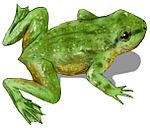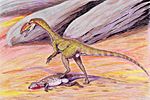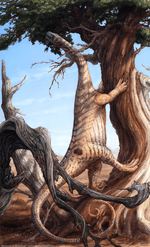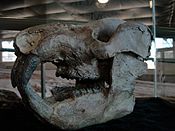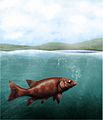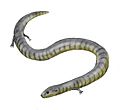Kayenta Formation facts for kids
Quick facts for kids Kayenta FormationStratigraphic range: Sinemurian-Pliensbachian, 196.5–183.0Ma |
|
|---|---|
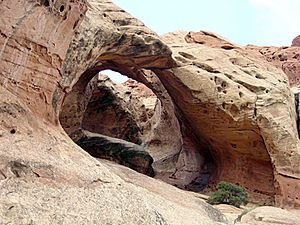
Kayenta Formation, Capitol Reef National Park, Utah.
|
|
| Type | Geological formation |
| Unit of | Glen Canyon Group |
| Underlies | Navajo Sandstone |
| Overlies | Wingate Sandstone |
| Thickness | 100 to 120 metres (330 to 390 ft) |
| Lithology | |
| Primary | Sandstone |
| Other | Siltstone, Limestone |
| Location | |
| Coordinates | 37°48′N 110°36′W / 37.8°N 110.6°W |
| Country | United States |
| Extent | northern Arizona, northwest Colorado, Nevada, and Utah |
| Type section | |
| Named for | Kayenta, Arizona |
The Kayenta Formation is a special rock layer found in the Glen Canyon Group. It stretches across a large area of the United States, including northern Arizona, northwest Colorado, Nevada, and Utah.
This rock formation is very famous in southeastern Utah. You can see it in many national parks and monuments. These include Zion National Park, Capitol Reef National Park, the San Rafael Swell, and Canyonlands National Park.
The Kayenta Formation often looks like a thinner, darker, broken layer of rock. It sits below the Navajo Sandstone and above the Wingate Sandstone. All three of these formations belong to the same rock group. Together, they can create huge cliffs that are over 2,000 feet (610 m) tall! Kayenta layers are usually red to brown. They form broken ledges on the landscape.
Contents
Exploring the Kayenta Formation in Utah
Kayenta Rocks in Southeast Utah
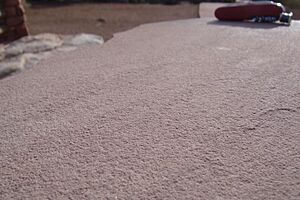
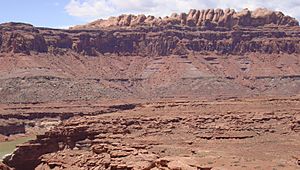
In most places where you find the three main rock layers of the Glen Canyon group, the Kayenta is easy to spot. Even from far away, it looks like a dark-red, maroon, or purple band. This band is made of thin layers of rock. It sits between two thick, light-colored layers of rock.
The Kayenta Formation often creates a flat area or bench. This happens because its softer rocks wear away more easily. The Kayenta is made of sandstone, shale, and limestone. These layers are not continuous. They look like they were made by streams that changed their path and water level often.
The sandstone layers can be from less than 1-inch (25 mm) to over 10 feet (3.0 m) thick. They are made of tiny, rounded quartz grains. These grains are glued together by lime and iron. The thicker sandstone layers have cross bedding, which means the layers are tilted. The shales are very fine sandstones. They contain round lumps of lime and hardened mud. The limestone appears as solid gray-blue layers. These can be a few inches to a few feet thick.
Overall, the Kayenta is very different from the rock layers above and below it. It has a different makeup, color, and way of layering. This shows that the environment changed a lot when these layers were being formed. Sometimes, the change from the Wingate Sandstone to the Kayenta is slow. But in many places, the contact is uneven. This means that the Kayenta rocks filled in dips and valleys that were carved into the Wingate layer below.
For example, in Moqui Canyon, a thick layer of Kayenta limestone fills a long, winding valley cut into the Wingate. The same can be true for the contact between the Kayenta and the Navajo. Sometimes it's a smooth change. But often, there's a messy mix of sandstone, shale, and mud at the bottom of the Navajo layer.
You can also find mudcracks and ripple marks in the top layer of the Kayenta. These signs tell us that the Kayenta and Wingate layers were sometimes exposed to the air and erosion before the next layers were laid down.
Kayenta Rocks in Southwest Utah
The red and purple Kayenta siltstones and sandstones form the slopes at the bottom of the Navajo Sandstone cliffs. These rocks tell us about ancient streams that flowed with low to medium energy. Scientists believe these streams flowed east. They deposited about 150 to 210 metres (490 to 690 ft) of sediment here.
You can clearly see the signs of ancient river channels and flood plains in the rocks. These are visible on the winding paths below the tunnel in Pine Creek Canyon.
In the southeastern part of Zion National Park, there's a special layer of cross-bedded sandstone. It's about halfway up the Kayenta Formation. This sandstone layer actually connects with the Navajo Formation further east. This shows that a desert environment briefly existed in this area during the time the Kayenta was forming. This layer is the ledge that provides shade on the lower part of the Emerald Pool Trail. It is actually considered part of the Navajo Formation, not the Kayenta.
Fossil mudcracks show that the area had seasons with wet and dry periods. Thin limestone layers and fossilized trails of water-dwelling snails or worms tell us that there were ponds and lakes.
But the most exciting fossils are the dinosaur tracks! These are quite common in the Kayenta mudstone. The tracks come in different sizes. But they all seem to be from three-toed reptiles that walked upright. They left their footprints in the mud of the flood plains. Sadly, no dinosaur bones have been found in this area yet. So, scientists can't identify the exact dinosaurs that made the tracks.
During the time the Kayenta Formation was created, the area of Zion was likely similar to Senegal today. It had rainy summers and dry winters. It was on the southern edge of a huge desert. However, North America was slowly moving north. This meant the desert's influence was about to become much stronger.
Kayenta Formation in Glen Canyon
The Kayenta Formation in Glen Canyon is about 400 feet (120 m) thick. It is made of fine-grained sandstone mixed with layers of siltstone. These alternating layers create a series of ledges and slopes. They sit between the tall cliffs of the Navajo and Moenave formations.
Dinosaur tracks are quite common in the siltstone layers. You can also find fresh water mussels and snails, but they are rare. The Kayenta Formation is pale red. This color adds to the beauty of the Vermilion Cliffs. These rocks were formed from sediments deposited by ancient rivers.
Ancient Animals of the Kayenta Formation
Color key
|
Notes Uncertain or tentative taxa are in small text; |
Amphibians
| Amphibians found in the Kayenta Formation | ||||||
|---|---|---|---|---|---|---|
| Genus | Species | Location | What was found | Notes | Images | |
|
Prosalirus |
|
|||||
Turtles and Tortoises
| Testudinatans (turtles and tortoises) found in the Kayenta Formation | ||||||
|---|---|---|---|---|---|---|
| Genus | Species | Location | What was found | Notes | Images | |
|
Kayentachelys |
|
|||||
Crocodile Relatives
| Crocodylomorphs (ancient crocodile relatives) found in the Kayenta Formation | ||||||
|---|---|---|---|---|---|---|
| Genus | Species | Location | What was found | Notes | Images | |
|
Kayentasuchus |
K. walkeri |
Arizona. |
||||
|
Eopneumatosuchus |
E. colberti |
Arizona. |
||||
|
Calsoyasuchus |
C. valliceps |
Arizona. |
||||
Dinosaur Relatives
Indeterminate ornithischian remains located in Arizona, USA. Ornithischian tracks located in Arizona, USA. An unnamed Heterodontosaurid genus located in Arizona, USA. Indeterminate theropod remains located in Arizona, USA. Theropod tracks located in Arizona and Utah, USA. Possible theropod tracks located in Arizona, Colorado, and Utah, USA. Unnamed coelophysoid genus located in Arizona, USA. A indeterminate basal thyreophoran is known from the formation.
| Ornithodires (dinosaur relatives) found in the Kayenta Formation | ||||||
|---|---|---|---|---|---|---|
| Genus | Species | Location | What was found | Notes | Images | |
|
D. wetherilli |
|
"2 associated subadult skeletons, partial skeleton, 4 other fragmentary individuals." |
||||
|
Kayentavenator |
K. elysiae |
|
Originally thought to be M. kayentakatae. |
|||
|
Sarahsaurus |
Sarahsaurus aurifontanalis |
|
Originally thought to be Massospondylus. |
|||
|
C. kayentakatae |
|
"1 articulated skull and postcranial skeleton, 2 fragmentary skeletons, 1 incomplete skeleton" Both adults and sub adults are known from the formation. |
Also known as Syntarsus or Megapnosaurus. |
|||
|
Rhamphinion |
R. jenkinsi |
|
A pterosaur (flying reptile). |
|||
|
S. lawleri |
|
"Fragmentary skull and skeleton from at least [two] individuals." |
||||
Mammal Relatives
| Tritylodonts (ancient mammal relatives) of the Kayenta Formation | ||||||
|---|---|---|---|---|---|---|
| Genus | Species | Location | What was found | Notes | Images | |
|
Dinnebitodon |
D. amarali |
Arizona, USA. |
||||
|
Kayentatherium |
K. wellesi |
Arizona, USA. |
||||
|
Oligokyphus |
O. sp. |
Arizona, USA. |
||||
Images for kids
-
Redbeds including the Kayenta Formation and the Navajo Sandstone in Kolob Canyons, Zion National Park, Utah, USA


